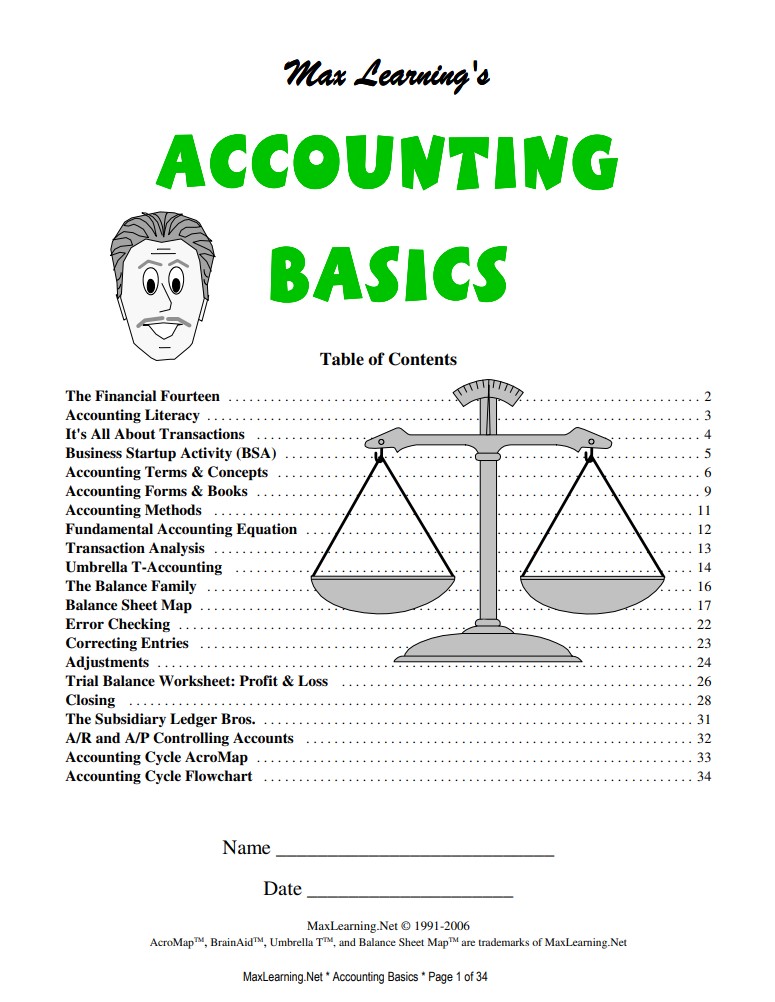|
MaxLearning.Net | ||
| Home: https://www.maxlearning.net * Email: mike.weinberg1952@gmail.com |
|
|
| Topic |
Text |
Video |
|
Accounting Basics This is the original handout I used to teach classes years ago. As I update each section, I'll post it separately below. |
 34 pages |
|
|
A Brief History of Accounting |
 2 pages |
|
|
Financial Fourteen Although you may not yet be familiar with these fundamental accounting terms, memorize them word for word. Post the Wall Chart for easy reference and carry the Flash Cards to study. (Refer to "Additional Topics" below for more terms, concepts, forms, and methods.) |
 3 pages |
|
|
Start
A Business What could you do or make that others would be willing to pay for? What items would you need to have on hand to provide that service or product? How would you pay for or "fund" those items? In this activity, your total startup costs must exactly match your total sources of money. |
 2 pages |
|
|
Fundamental Accounting Equation: A =
L + OE Assets are funded from Liabilities plus Owners Equity, the basic formula of Double Entry Accounting. The confusion starts when things are perceived as being doubled. Only Assets are "real" in the truest sense. |
||
|
Transaction Analysis: T-Accounting The genius of Double Entry Accounting is that if each debit entry is matched by a corresponding credit entry, the Fundamental Accounting Equation stays balanced. Accounts are arranged in T shapes with debits on the left and credits on the right. The trick is to know which side of the T goes up. |
||
|
Tree Accounting This is T-Accounting on steroids! It takes the guesswork out of "which side goes up?" by arranging T-accounts into a hierarchy of parent-child trees arranged by category. |
||
|
Balance
Sheet Map This one-page, multipurpose worksheet (journal, ledger, trial balance, income statement, balance sheet) lets you analyze and verify transactions before entering them into paper or computerized accounting forms. |
||
|
Startup Transactions |
||
|
Error Checking: 1A-9TS-OD |
||
|
Correcting Entries |
||
|
Adjustments |
||
|
Trial Balance Worksheet |
||
|
Closing |
||
|
Accounting Cycle AcroMap |
||
|
Accounting Cycle Flowchart |
||
| Additional Topics | ||
|
Accounting Terms, Concepts, &
Occupations One of the more frustrating aspects of accounting is the ambiguous use of terminology, including job titles. Even accounting textbooks and firms don't always agree. |
||
|
Accounting Forms Like accounting terminology, accounting forms differ. This section illustrates the key elements of these standard forms: Chart of Accounts, Journal, Ledger, Trial Balance, Income Statement, Balance Sheet. |
||
|
Accounting Methods Cash vs. Accrual Accounting. Single Entry vs. Double Entry accounting. |
||
|
Subsidiary Ledgers & Controlling
Accounts |
||
|
Cash Flow Statement |
||
 Hi,my name is B.N. Counter. Business is all about exchanging items of value. Accounting is essentially "a counting"
of these transactions. It tells us whether a firm is doing well, how much it has and how much it owes. Since the days of
simple bartering, accounting has become very complex, developing a vocabulary and procedures that can befuddle even the
sharpest minds. In these lessons, we'll use stories, characters, and special tools to help Double Entry accounting make
more sense to the casual student, business owner, or nonprofessional.
Hi,my name is B.N. Counter. Business is all about exchanging items of value. Accounting is essentially "a counting"
of these transactions. It tells us whether a firm is doing well, how much it has and how much it owes. Since the days of
simple bartering, accounting has become very complex, developing a vocabulary and procedures that can befuddle even the
sharpest minds. In these lessons, we'll use stories, characters, and special tools to help Double Entry accounting make
more sense to the casual student, business owner, or nonprofessional.